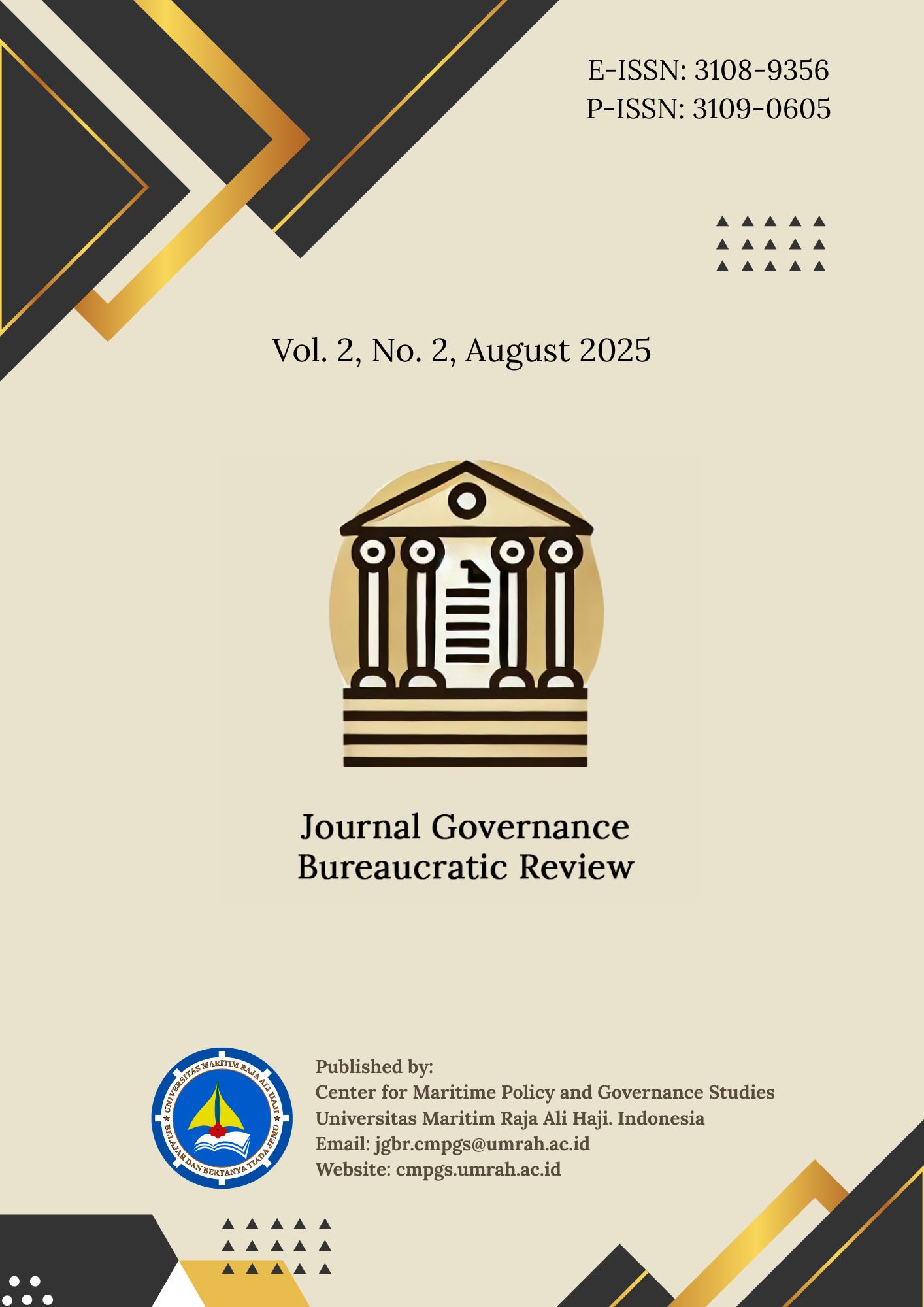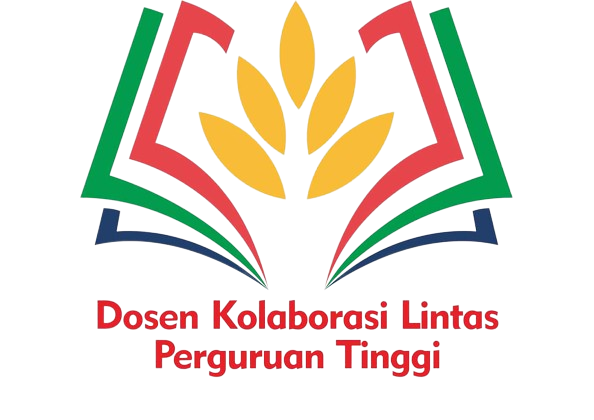Implementation of the TPKS Law In DIY From the Perspective of Policy Network Theory
DOI:
https://doi.org/10.31629/jgbr.v2i2.7758Keywords:
TPKS Law, Policy Implementation, Policy Network TheoryAbstract
The increasing prevalence of sexual violence in Indonesia has posed a major governance challenge, prompting the enactment of Law Number 12 of 2022 concerning Sexual Violence Crimes (TPKS Law). Despite this progressive legal framework, its implementation at the local level, particularly in the Special Region of Yogyakarta (DIY), remains fraught with structural, institutional, and socio‐cultural obstacles. This study aims to analyze how the TPKS Law is implemented within the context of multi‐actor collaboration by employing Policy Network Theory as an analytical lens. The research seeks to identify key actors, map their relationships, and evaluate how coordination mechanisms influence policy outcomes. Using a qualitative descriptive approach, the study draws upon secondary data sources, including government reports, academic publications, and NGO documentation, which were analyzed through content and thematic analysis. The findings reveal that the effectiveness of the TPKS Law depends largely on the strength of horizontal coordination among actors such as the Yogyakarta Regional Police, DP3AP2 DIY, NGOs like and local communities. While legal institutions provide authority and structure, NGOs contribute trust and community engagement, creating a complementary but asymmetrical network. The study concludes that successful implementation of the TPKS Law in Yogyakarta requires adaptive governance practices characterized by continuous learning, inter‐agency collaboration, and community participation.
Downloads
References
Avelino, F., & Wittmayer, J. M. (2016). Shifting power relations in sustainability transitions: A multi-actor perspective. Journal of Environmental Policy and Planning, 18(5), 628–649. https://doi.org/10.1080/1523908X.2015.1112259
Bulut, B., & Kar, H. (2025). Sexual violence via social media. Journal of Forensic and Legal Medicine, 114, 102908. https://doi.org/10.1016/J.JFLM.2025.102908
Busenberg, G. J. (1999). Collaborative and adversarial analysis in environmental policy. Policy Sciences, 32(1), 1–11. https://doi.org/10.1023/A:1004414605851/METRICS
Colombino, N., Mercado, C. C., Levenson, J., & Jeglic, E. (2011). Preventing sexual violence: Can examination of offense location inform sex crime policy? International Journal of Law and Psychiatry, 34(3), 160–167. https://doi.org/10.1016/J.IJLP.2011.04.002
Creswell, J. W., & Creswell, J. D. (2018). Research design. Qualitative, quantitative, and mixed methods approaches (5th ed.). SAGE Publications.
Dartnall, E., & Jewkes, R. (2013). Sexual violence against women: The scope of the problem. Best Practice & Research Clinical Obstetrics & Gynaecology, 27(1), 3–13. https://doi.org/10.1016/J.BPOBGYN.2012.08.002
Gao, P., Kothari, A., & Lei, Y. H. (2025). Safe spaces for children: School sanitation and sexual violence. European Economic Review, 172, 104952. https://doi.org/10.1016/J.EUROECOREV.2025.104952
Hardaker, S. (2025). Platformizing structural policy instruments? Fostering (infrastructural) power in the context of Digital Free Trade Zones. Geoforum, 160, 104218. https://doi.org/10.1016/J.GEOFORUM.2025.104218
Henry, N., & Powell, A. (2016). Sexual Violence in the Digital Age: The Scope and Limits of Criminal Law. Social and Legal Studies, 25(4), 397–418. https://doi.org/10.1177/0964663915624273;CTYPE:STRING:JOURNAL
Heuwinkel, K., & Pillmayer, M. (2025). #MeToo in hiking activities – Which risks exist for (solo) female hikers? Methodological reflections to approach sexual harassment and gender-based violence. Journal of Outdoor Recreation and Tourism, 52, 100978. https://doi.org/10.1016/J.JORT.2025.100978
Hill, Michael., & Hupe, Peter. (2021). Implementing Public Policy : An Introduction to the Study of Operational Governance. SAGE Publications Ltd.
Innes, J. E., & Booher, D. E. (2010). Planning with complexity: An introduction to collaborative rationality for public policy. Planning with Complexity: An Introduction to Collaborative Rationality for Public Policy, 1–237. https://doi.org/10.4324/9780203864302
Ji, S. G. (2025). #MeToo in an AI-generated deepfake sexual violence era in South Korea. Women’s Studies International Forum, 112, 103146. https://doi.org/10.1016/J.WSIF.2025.103146
Lang, A. (2019). Collaborative Governance in Health and Technology Policy: The Use and Effects of Procedural Policy Instruments. Administration and Society, 51(2), 272–298. https://doi.org/10.1177/0095399716664163
Lankford, A. (2021). A sexual frustration theory of aggression, violence, and crime. Journal of Criminal Justice, 77, 101865. https://doi.org/10.1016/J.JCRIMJUS.2021.101865
Lankford, A., & Evans, H. R. (2025). Sexual frustration, murder, and violent crime: A direct assessment of incarcerated offenders. Journal of Criminal Justice, 101, 102544. https://doi.org/10.1016/J.JCRIMJUS.2025.102544
Leach, W. D., Pelkey, N. W., & Sabatier, P. A. (2002). Stakeholder Partnerships as Collaborative Policymaking: Evaluation Criteria Applied to Watershed Management in California and Washington. Journal of Policy Analysis and Management, 21(4), 645–670. https://doi.org/10.1002/PAM.10079;WGROUP:STRING:PUBLICATION
López-Ossorio, J. J., Santos-Hermoso, J., & Sánchez Camañ, A. (2025). Group sexual violence in Spain. Characterization of a complex phenomenon. Spanish Journal of Legal Medicine, 51(3), 500461. https://doi.org/10.1016/J.REMLE.2025.500461
McCarthy, A., Rudolph, J. I., Fry, D., Monks, C. P., Pacella, R., & Meinck, F. (2025). Measuring sexual violence against children in a national prevalence survey in the UK: Questionnaire development and content validity. Child Abuse & Neglect, 167, 107582. https://doi.org/10.1016/J.CHIABU.2025.107582
Moller, M. (2025). Forensic medical responses to sexual violence as international crimes. Pathology, 57, S11. https://doi.org/10.1016/J.PATHOL.2024.12.052
Schäfer, J., & Amelina, A. (2025). Gendered and sexualized violence on the move: unravelling collective (im)mobilization in the name of post-Soviet imperial membership. Mobilities. https://doi.org/10.1080/17450101.2025.2532393
Sellers, P. V. (1999). The Cultural Value of Sexual Violence. Proceedings of the ASIL Annual Meeting, 93, 312–324. https://doi.org/10.1017/S027250370006780X
Solorzano Telechea, J. A. (2007). Fama publica, infamy and defamation: judicial violence and social control of crimes against sexual morals in medieval Castile. Journal of Medieval History, 33(4), 398–413. https://doi.org/10.1016/J.JMEDHIST.2007.09.001
Spohn, C., & Tellis, K. (2012). The Criminal Justice System’s Response to Sexual Violence. Violence Against Women, 18(2), 169–192. https://doi.org/10.1177/1077801212440020;WEBSITE:WEBSITE:SAGE;REQUESTEDJOURNAL:JOURNAL:VAWA;ISSUE:ISSUE:DOI
Toyibah, D., & Riyani, I. (2025). Contesting religious authority in response to government regulations on the prevention and handling of campus sexual violence (CSV) in Indonesia. Women’s Studies International Forum, 110, 103085. https://doi.org/10.1016/J.WSIF.2025.103085
Zhang, C., & Zhang, B. (2025). Willingness to report hate crimes: How attitudes, police perceptions, and sexual orientation shape bystander response. Journal of Criminal Justice, 97, 102375. https://doi.org/10.1016/J.JCRIMJUS.2025.102375
Downloads
Published
Issue
Section
License
Copyright (c) 2025 Zahmil Husein, Rangga Rangga, Kevin Andika Putra, Muhammad Padillah, Muhammad Nabiel Azirah Djou, Gea Ananda Putri Septiyanti

This work is licensed under a Creative Commons Attribution-ShareAlike 4.0 International License.
You are free to:
- Share — copy and redistribute the material in any medium or format for any purpose, even commercially.
- Adapt — remix, transform, and build upon the material for any purpose, even commercially.
- The licensor cannot revoke these freedoms as long as you follow the license terms.
Under the following terms:
- Attribution — You must give appropriate credit, provide a link to the license, and indicate if changes were made . You may do so in any reasonable manner, but not in any way that suggests the licensor endorses you or your use.
- ShareAlike — If you remix, transform, or build upon the material, you must distribute your contributions under the same license as the original.
- No additional restrictions — You may not apply legal terms or technological measures that legally restrict others from doing anything the license permits.













